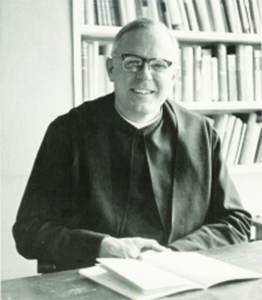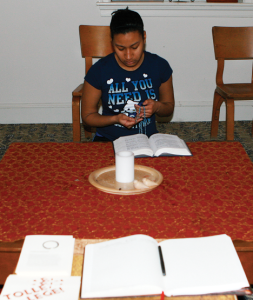Meditation and Reflection at the John Main Center
For many Georgetown students, busy schedules and marked-up planners are the norm. With such a fast-paced college culture, multitasking has become a necessity. Such a strong emphasis on activity leaves little room for contemplation. The John Main Center for Meditation and Inter-religious Dialogue, however, provides a space for reflection. Aiming to promote mindfulness and meditation on campus, the center is a source of support for many students regardless of their faith or background.
The JMC is housed in Anne Marie Becraft Hall, the oldest building on campus, which is at the corner of Old North Way and Library Walk, across from New South. The center derives its name from Fr. John Main, an Irish Benedictine monk who is best known for developing his own method of Christian meditation incorporating mantra, a sacred prayer word or phrase.

JOHN MAIN MEDITATION CENTER
Pictured above, Fr. John Main
His teachings have been upheld by the World Community for Christian Meditation, which, in collaboration with Georgetown University, established the JMC in 2005. The JMC is considered a non-profit organization of the American chapter of the WCCM.
Twelve years after its conception, the JMC remains an integral component of spiritual life at Georgetown. The building consists of a large, sunlit room lined with floor pillows and chairs. Additionally, a large center table contains scriptures from a number of religious traditions.
Although the JMC is open for private meditation, many visitors opt for silent group meditation sessions, which are held every weekday at 12:30 p.m. and 6:00 p.m., as well as 10:00 a.m. Tuesdays through Thursdays. The center also hosts Buddhist meditations Monday and Thursday evenings and Quaker meetings Tuesday evenings, in addition to weekly meditation sessions in partnership with Georgetown University’s Counseling and Psychiatric Service. The services provided by the JMC are free of charge.
Nicholas J. Scrimenti (COL ’18) is the JMC program coordinator and leader of the new Student Advisory Committee. His advice for beginners is simply to start attending group meditation, especially because meetings open with instructions for newcomers. Scrimenti describes the JMC as a “very welcoming community.”
Still, some students question whether they truly have the time to commit to meditating.
“Meditation is a centering force that guides our concentration to the matter at hand and, in effect, makes time more spatial,” Scrimenti said in an email to The Hoya.
He further explained that the practice of meditation is adaptable and easy to integrate into one’s daily routine. Ideally, it should become something individuals look forward to doing.
JMC Director Elizabeth Cardone offers similar advice for those looking to begin meditating. She suggests taking half an hour to visit the JMC.
“Ideally, students should spend time in meditation every morning and every evening. Even five minutes can serve to refresh and energize the soul,” Cardone said. “Once you develop a routine of meditation, you will find it has a positive impact on time managements skills, and you may find a healthy realignment of your priorities.”
Other students may feel deterred from the practice due to its seeming difficulty. Cardone stresses the importance of not judging one’s “performance” when meditating. Ultimately, the practice offers long-term benefits and transformative effects.
“Meditation reduces stress and anxiety, improves sleep patterns, boosts the immune system and promotes overall well-being,” Cardone said. “Additionally, meditation can have a powerful benefit for those hoping to overcome trauma or addictive behaviors.”
Scrimenti echoes these beliefs yet said he believes that focus should not be limited to the outcome of meditating.

Perhaps the most powerful feature of meditation lies in its ability to transcend religion. As students and faculty sit together, their respective faiths are cast aside. Cardone puts it best, stating: “Silence can be a universal language.”
Despite the center’s Christian roots, the JMC celebrates a diverse range of spiritual traditions. At group meetings, for example, scriptures of any religion may be read before or after meditation.
Cardone states that inter-religious dialogue is sparked through the center’s promotion of external programs, such as the Way of Peace Fellowship. Georgetown students from all backgrounds are encouraged to apply. Those accepted will attend the Way of Peace Conference hosted by Catholic University of America in April.
Involvement with the JMC promises plenty of opportunities, as well as the chance to meet and connect with new people. Regardless of one’s motivations to pursue meditation, its reflective, cathartic potential carries a wide array of possibilities.
Furthermore, it is one of the best ways to achieve mindfulness, defined by the Foundation for a Mindful Society as “the basic human ability to be fully present, aware of where we are and what we’re doing, and not overly reactive or overwhelmed by what’s going on around us.”
The JMC’s doors are open to all, regardless of one’s experience with meditation or personal faith. Visitors are united through a common belief in integrating mindfulness into their daily routines and can certainly attest to its positive effects.
“The gift of meditation will change your life,” Cardone said. “Come and see for yourself.”
Written by Meena Raman, Class of 2020. This article was originally published in The Hoya on February 3, 2017 and can be found online here.
- Tagged
- Buddhist
- john main center